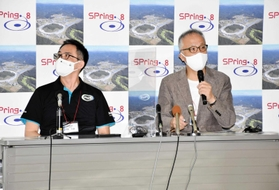
Spring 8: Sand particle analysis of asteroid Ryugu: Spacecraft Hayabusa2
-Researcher “Expecting a Surprise”-
Spacecraft Hayabusa2:
It has been about 6 months since the capsule containing the sand of the asteroid Ryugu was returned to Earth in December last year.
Japan Agency for Marine-Earth Science and Technology:
Initial analysis of the particles began on June 20th.
It may lead to elucidation of the origin of water and life.
Large synchrotron radiation facility: “Spring 8”
Large-scale radiation facility “Spring 8” boasting one of the best performance in the world (1 Koto, Sayo-cho, Hyogo Prefecture)
The researchers involved are also excited about their expectations.
Japan Aerospace Exploration Agency: (JAXA)
Eight particles provided by JAXA will be analyzed.
The maximum size is about 4 mm in diameter.
Ryugu:
Ryugu has the following possibilities.
Organic matter 4.6 billion years ago when the solar system was created,
Minerals containing water remain.
Particle analysis started:
It is stored in a nitrogen-filled container that is “hard to react” to prevent the particles from deteriorating.
The equipment will be operated continuously for 72 hours until the 23rd, and the analysis will be challenged.
High resolution CT:
The particles are rotated by high resolution computed tomography (CT).
Record 1800 to 3600 images per grain.
Make a stereoscopic image to understand the structure of the substance that forms the particles.
Analysis with Spring 8:
A method called “X-ray diffraction method” is used for detailed analysis.
The characteristics and types of substances can be identified from the direction of travel of the atoms and molecular X-rays of the substance.
It is also possible to know what kind of substance is in which part of the particle.
Kobe Shimbun NEXT | Nishihari
https://www.kobe-np.co.jp/news/seiban/202106/sp/0014434952.shtml